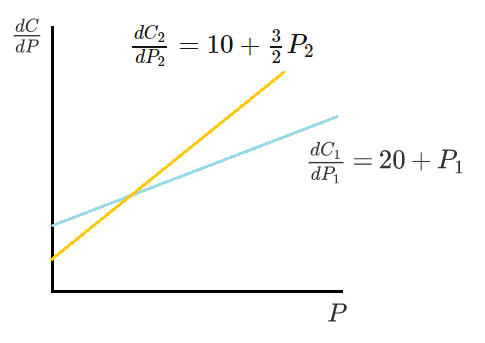Optimal Generator Dispatch
Suppose we have two electric generators. The amounts of power supplied by the generators are and for Generators 1 and 2, respectively. The cost per unit time to run Generator 1 is , and the cost per unit time to run Generator 2 is . The parentheses indicate that the cost is a function of the amount of power generated.
Suppose we want the generators to supply 100 units of power together, and minimize the running cost while doing so.
Some plots of are shown below for the two generators.

How many units of power should Generator 1 supply?
The answer is 56.
This section requires Javascript.
You are seeing this because something didn't load right. We suggest you, (a) try
refreshing the page, (b) enabling javascript if it is disabled on your browser and,
finally, (c)
loading the
non-javascript version of this page
. We're sorry about the hassle.
Write the total cost as a function of the amount P supplied by generator 1: C ( P ) = C 1 ( P ) + C 2 ( 1 0 0 − P ) ; d P d C = d P 1 d C 1 − d P 2 d C 2 = ( 2 0 + P 1 ) − ( 1 0 + 2 3 P 2 ) = ( 2 0 + P ) − ( 1 6 0 − 2 3 P ) = 2 5 P − 1 4 0 . Since this is a continuous, differentiable function on domain P ∈ [ 0 , 1 0 0 ] , the minimum either lies at an edge of the domain or at the zero of d C / d P .
If P = 0 then d C / d P = − 1 4 0 , showing that increasing P leads to a decrease in the cost; thus P = 0 is not a minimum.
If P = 1 0 0 then d C / d P = + 1 1 0 , showing that decreasing P also leads to a decrease in cost; P = 1 0 0 is not a minimum.
This leaves 0 = d P d C = 2 5 P − 1 4 0 , P = 5 6 .